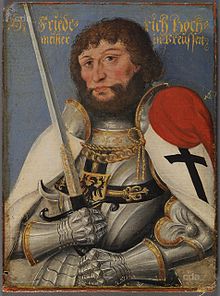Friedrich of Saxony (1473–1510)

Friedrich von Sachsen , also Friedrich von Wettin , (born October 26, 1473 in Torgau , † December 14, 1510 in Rochlitz ) was the 36th Grand Master of the Teutonic Order from 1498 to 1510 .
Life
He was the third (and youngest surviving) son of Albrecht the Beherzten and Zdena (Sidonie), the daughter of Georg von Podiebrad of Bohemia († 1510 in Tharandt ).
From 1491 to 1495 he studied at the universities of Siena , Bologna and Leipzig . He then entered service at the court of Archbishop Berthold von Henneberg in Mainz, Arch Chancellor of the Holy Roman Empire.
In 1498 he joined the Teutonic Order with the sole purpose of becoming Grand Master . His official election took place on September 29, 1498. Friedrich immediately initiated an extensive and energetic reform policy to rebuild and financially recover the religious state and to protect the common people from attacks. He achieved this through increased visitations and the creation of an audit commission to control expenditure. Friedrich also ordered the establishment of a court court ("Quatember") as the highest legal instance of the state. In general, he began to restructure the religious order along the lines of a German territorial principality. Another measure was the reform of the coin system. Within a short time, Friedrich von Sachsen became one of the most popular grand masters of all.
In 1503 the Prussian state order for the systematization of laws and customs was passed. In 1507 the Prussian order of war followed to restructure the military force. This recorded around 18,000 citizens fit for military service, who were distributed among a field army of 10,000 men and castle garrisons of 8,000 men.
Due to Frederick's persistent refusal to swear allegiance to the King of Poland, the order country was threatened with war with Poland during its entire term of office. For security reasons, he therefore moved his residence to his home in Rochlitz in Saxony in 1507 . The management in Prussia was meanwhile with the Grand Commander . At the Reichstag in Worms in May 1509 he successfully challenged the Second Peace of Thor against Poland.
He died on December 14, 1510 in Rochlitz and was buried in the Princely Chapel in Meißen Cathedral.
ancestors
| Pedigree of Friedrich of Saxony | ||||||||
|---|---|---|---|---|---|---|---|---|
| Great-great-grandparents |
Margrave |
Duke |
Duke |
Boček II of Podebrady (–1417) |
? |
? |
||
| Great grandparents |
Elector Friedrich I of Saxony (1370–1428) |
Duke Ernst the Iron (1377–1424) |
Viktorin von Podiebrad (1403–1427) |
Smil von Sternberg (–1431) |
||||
| Grandparents |
Elector Friedrich II. (1412–1464) |
King George of Podebrady (1420–1471) |
||||||
| parents |
Duke Albrecht the Courageous (1443–1500) |
|||||||
|
Friedrich of Saxony |
||||||||
literature
- Kurt Forstreuter: Friedrich, Duke of Saxony. In: New German Biography (NDB). Volume 5, Duncker & Humblot, Berlin 1961, ISBN 3-428-00186-9 , p. 526 ( digitized version ).
- Carl August Lückerath: Friedrich von Wettin, Grand Master of the Teutonic Order (1473–1510) . In: Lexicon of the Middle Ages (LexMA). Volume 4, Artemis & Winkler, Munich / Zurich 1989, ISBN 3-7608-8904-2 , Sp. 961 f.
- Friedrich Borchert: The Grand Masters of the Teutonic Order in Prussia. In: Preussische Allgemeine Zeitung of August 16, 2003.
| personal data | |
|---|---|
| SURNAME | Friedrich of Saxony |
| ALTERNATIVE NAMES | Friedrich von Wettin |
| BRIEF DESCRIPTION | Grand Master of the Teutonic Order |
| DATE OF BIRTH | October 26, 1473 |
| PLACE OF BIRTH | Torgau |
| DATE OF DEATH | December 14, 1510 |
| Place of death | Rochlitz |
